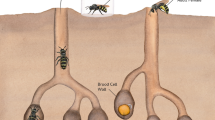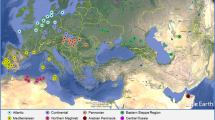Summary
Nutritional balance of larval food supposedly plays an important role in honey bee caste formation. Whether this is similar in stingless bees was an open question. We analysed the major water-soluble constituents in the larval food of 7 species of meliponids. The data were used to evaluate the hypothesis that a balanced composition of larval food is shaped by selection. Chemosystematic trees were calculated and compared to a published phylogenetic tree based on morphological characters. A considerable degree of congruence between the chemosystematic trees for the general composition of larval food and the phylogenetic tree allowed us to discuss the composition of larval food in highly eusocial bees in relation to functional aspects of larval nutrition.
Zusammenfassung
Die ausgewogene Zusammensetzung des Larvenfutters wird allgemein als ein wichtiger Faktor in der Kastenbildung der Honigbiene angesehen. Ob dies für Stachellose Bienen in ähnlicher Weise gilt, war eine offene Frage. Wir analysierten die wasserlöslichen Hauptkomponenten im Larvenfutter von 7 Meliponinen-Arten. Die Ergebnisse wurden herangezogen, um die Hypothese zu überprüfen, daß eine ausgewogene Zusammensetzung des Larvenfutters der Selektion unterliegt. Dazu wurden chemosystematische Bäume berechnet und mit einem bereits publizierten, strukturell-morphologisch begründeten Stammbaum verglichen. Ein beträchtlicher Grad an Kongruenz zwischen den chemosystematischen Bäumen für die allgemeine Zusammensetzung des Larvenfutters und dem Stammbaum erlaubte es, die Zusammensetzung des Larvenfutters hoch-eusozialer Bienen in Bezug auf die funktionalen Aspekte der Larvenernährung zu diskutieren.
Similar content being viewed by others
References
Asencot M., Lensky Y., 1976.—The effect of sugars and juvenile hormone on the differentiation of the female honeybee larvae (Apis mellifera L.) to queens.Life Sci., 18, 693–700.
Bradford M.M., 1976.—A rapid and sensitive method for the quantification of microgram quantities of protein utilizing the principle of protein-dye binding.Analyt. Biochem., 72, 248–254.
Brouwers E.V.M., 1984.—The glucose-fructose ratio in the food of the honebeey larvae.J. Apic. Res., 23, 94–101.
Camargo C.A. de, 1972.—Determinação de castas emScaptotrigona postica Latreille (Hymenoptera, Apidae).Rev. Brasil. Biol., 32, 133–138.
Darchen R., Delage-Darchen B., 1970.—Facteur déterminant les castes chez les Trigones (Hymnepotères Apides).C.R. Acad. Sci. Paris, 270, 1372–1373.
Darchen R., Delage-Darchen B., 1971.—Le déterminisme des castes chez les Trigones (Hyménoptères, Apidés).Insectes Soc., 18, 121–134.
Dietz A., Haydak M., 1971.—Caste determination in honeybees. I. The significance of moisture in larval food.J. Exp. Zool., 177, 353–358.
Dixon S.E., Shuel R.W., 1963.—Studies in the mode of action of royal jelly in honeybee development. III. The effect of experimental variation in diet on growth and metabolism of honeybee larvae.Can. J. Zool., 41, 733–739.
Farris J.S., 1972.—Estimating phylogenetic trees from distance matrices.Am. Nat., 106, 645–668.
Goewie E.A., 1978.—Regulation of caste differentiation in the honey bee (Apis mellifera L.). Ph.D. thesis Agricult. Univ. Wageningen,Med., Landbouwhogesch. Wageningen, 78, (15).
Halberstadt K., 1980.—Elektrophoretische Untersuchungen zur Sekretionstätigkeit der Hypopharynxdrüse der Honigbiene (Apis mellifera).Insectes Soc., 27, 61–77.
Handel, E. van, 1965.—Microseparation of glycogen, sugars and lipids.Analyt. Biochem., 11, 266–271.
Hartfelder K., 1987—Caste differentiation in stingless bees: A comparative analysis of larval food from 7 species. In:Chemistry and biology of social insects, Eder J., Rembold H., eds., Verl. Peperny, Munich, p. 174.
Howe S.R., Dimick P.S., Benton A.W., 1985.—Composition of freshly harvested and converted royal jelly.J. Apic. Res., 24, 52–61.
Imperatriz-Fonseca V.L., Kleinert-Giovannini A., Cortopassi-Laurino M., Ramalho M., 1984.—Hábitos de coleta deTetragonisca angustula angustula Latreille. (Hymenoptera, Apidae, Meliponinae).Bolm. Zool. Univ., S. Paulo, 8, 115–131.
Johnson L.K., Hubbell S.P., 1974.—Aggression and competition among stingless bees: Field studies.Ecology, 55, 120–127.
Kerr W.E., 1950.—Evolution of the mechanism of caste determination in the genusMelipona.Evolution, 4, 7–13.
Kerr W.E., Stort A.C., Montenegro M.S., 1966.—Importancia de alguns fatôres ambientais na determinâçao das castas do generoMelipona.Anais Acad. Bras., Ciências,38, 149–168.
Moure J.S. 1951.—Notas sôbre Meliponinae (Hymenopt.-Apoidea)Dusenia, 2, 25–70.
Moure J.S., 1961.—A preliminary supra-specific classification of the Old World meliponine bees (Hymenoptera, Apoidea).Studia Entomol., 4, 181–242.
Planta A. von, 1888.—Uber den Futtersaft der Bienen.Hoppe Seyler's Z. Physiol. Chem., 12, 327–354.
Rembold H., Lackner B., 1978.—Vergleichende Analyse von Weiselfuttersäften.Mitt. dt. Ges. allg. angew. Ent., 1, 299–301.
Rembold H., Lackner B., 1981.—Rearing of honeybee larvae in vitro: Effect of yeast extract on queen differentiation.J. Apic. Res., 20, 165–171.
Rembold H., Lackner B., Geistbeck I., 1974.—The chemical basis of honeybee,Apis mellifera, caste formation. Partial purification of queen bee determinator from royal jelly.J. Insect Physiol., 20, 307–314
Sakagami S.F., 1982.—Stingless bees. In: Hermann H.R., ed.,Social Insects, Vol. 3, Academic Press, New York, pp. 361–423.
Sasaki M., Tsuruta T., Asada S., 1987.—Role of the physical property of royal jelly in queen differentiation of honeybees. In:Chemistry and biology of social insects, Eder J., Rembold H., eds. Verl. Peperny, Munich, pp. 306–307.
Shuel R.W., Dixon S.E., 1968.—The importance of sugar for the pupation of the worker honeybee.J. Apic. Res., 7, 109–112.
Silva D.L.N. da, 1977.—Estudos bionômicos em colônias mistas de Meliponinae (Hymenoptera, Apoidea).Bolm Zool. Univ., S. Paulo, 2, 7–106.
Sneath P.H.A., Sokal R.R., 1973.—Numerical Taxonomy, Freeman, San Franscico, 573 pp.
Snyder T.P., 1977.—A new electrophoretic approach to biochemical systematics of bees.Biochem. Syst. Ecol., 5, 133–150.
Takenaka T., Takahashi E., 1980.—General chemical composition of the royal jelly.Bull. Fac. Agric. Tamagawa Univ., 20, 71–78.
Takenaka T., Takahashi E., 1983.—Proteins and peptides in royal jellyNippon Nôg.Kaishi, 57, 1203–1209.
Thrasyvoulou A.T., 1983.—Native and dissociated protein patterns of larval food of honeybees (Apis mellifera cecropia L.).Apidologie, 14, 225–232.
Weaver N., Kuiken K.A., 1951.—Quantitative analysis of the essential amino acids of royal jelly and some pollens.J. Econ. Entomol., 44, 635–638.
Weaver N., 1974.—Control of dimorphism in the female honeybee. 3. The balance of nutrients:J. Apic. Res., 13, 93–101.
Wille A., 1979.—Phylogeny and relationships among the genera and subgenera of the stingless bees (Meliponinae) of the world.Rev. Biol. Trop., 27, 241–277.
Wittmann D., Engels W. 1987.—Welche Diät ergibt Arbeiterinnen bei in vitro Aufzucht von Honigbienen?Apidologie, 18, 279–288.
Wray W., Boulkias T., Wray V.P., Hancock R., 1981.—Silver staining of proteins in polyacrylamide gels.Analyt. Biochem., 118, 197–203.
Author information
Authors and Affiliations
Rights and permissions
About this article
Cite this article
Hartfelder, K., Engels, W. The composition of larval food in stingless bees: Evaluating nutritional balance by Chemosystematic methods. Ins. Soc 36, 1–14 (1989). https://doi.org/10.1007/BF02225876
Received:
Accepted:
Issue Date:
DOI: https://doi.org/10.1007/BF02225876




